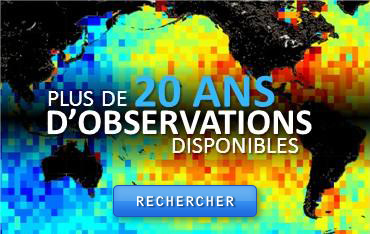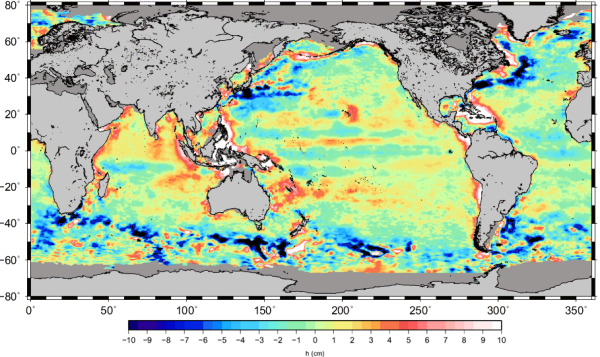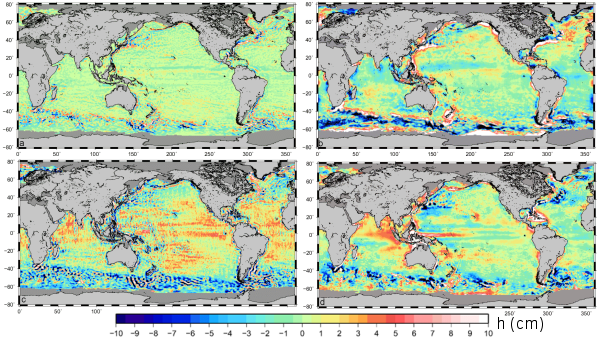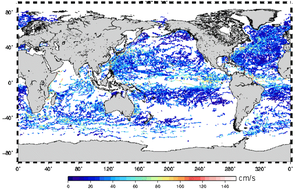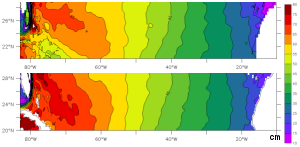Comparison of Global Mean Dynamic Topographies
The absolute differences between CNES-CLS13 and CNES-CLS09 MDTs are around 13 cm in high variability areas. Moreover we can point out differences higher than 15 cm around the Bahamas and the Indonesia. This is due to the use of improved first-guess (based on GOCE data) in the new MDT CNES-CLS13. We will see in following sections that these large modifications in these two specific regions should lead to important improvements for the assimilation of altimeter data into the Mercator-Ocean forecasting system but also should improve the estimation of meridional overturning transport.
We have performed quantitative comparisons with other existing MDT solutions: the first guess, the DNSC MDT (Andersen et al, 2009) based on the filtered difference between a MSS and a combined geoid model, the MDT from Maximenko et al (2009) based on GRACE and drifters, as well as the MDT from the GLORYS2V1 model reanalysis. The MDT differences are displayed on the following figure and the main statistics (mean and RMS of the differences) are given in the following table.
| CNES-CLS09 | Glorys | Max. 2009 | DNSC | First Guess | |
|---|---|---|---|---|---|
| Diff mean (cm) | 0.2 | 43.5 | 44.2 | 3.0 | -0.01 |
| Diff RMS (cm) | 3.5 | 3.4 | 5.1 | 4.4 | 1.9 |
Mean and Root Mean Square differences between the CNES-CLS13 MDT and different existing MDT solutions.
The difference with the first guess (a-) shows the impact of adding the short scales from the synthetic observations compared to the use of GOCE data only. This shows the very good performance of the GOCE data outside the strong gradient areas: no much information is brought by in-situ data. The differences with the GLORYS MDT (d-) shows similar patterns than the differences map with the CNES-CLS09 MDT as the CNES-CLS09 MDT was used for the assimilation of the altimeter SLA in the GLORYS reanalysis. The differences with the DNSC MDT is mainly dominated by residual geodetic noise in the DNSC solution.
The Max09 MDT is based on a rather old GRACE geoid model and SVP drifter data uncorrected for wind slippage. The difference with the new CNES-CLS13 MDT is the highest (5.1 cm RMS) compared to the other solutions (4.4 cm RMS for the DNSC MDT, 3.5 cm RMS for the CNES-CLS09 and the GLORYS MDTs).
Then, to enable quantitative comparison, we have used independent measurements of the ocean surface currents provided by SVP-type drifters processed in near-real time and distributed by the Coriolis datacenter for the period ranging from September 2012 to September 2013. The trajectories of the available drifters are displayed on the following figure. We see that the global ocean is not badly sampled so that our comparison results are representative of all regions. This near real-time drifter data have been processed like the delayed-time drifters to correct for the Ekman currents, the potential wind slippage, the residual ageostrophic currents, and the time dependent geostrophic anomaly. We therefore end up with an independent dataset of synthetic mean velocities.
In the following table we have displayed the statistical comparison results between these independent mean geostrophic velocities and the mean geostrophic velocities derived from the different MDT solutions listed above.
| MDT-CNES-CLS13 | MDT-CNES-CLS09 | MDT Glorys2V1 | MDT Max.08 | MDT GOCE (First Guess) | |
|---|---|---|---|---|---|
| RMS U | 42.17 | 43.89 | 44.95 | 43.52 | 44.31 |
| RMS v | 46.48 | 47.23 | 51.49 | 48.09 | 49.54 |
RMS differences (expressed in % of drifter velocity variance) between the mean velocities from the different MDT solutions and independent synthetic mean velocities computed using the real-time SVP velocity dataset distributed by the Coriolis datacenter.
Results are expressed in percentage of the independent drifter velocity variance. The RMS differences obtained for both components of the velocity are reduced when using the new CNES-CLS13 MDT compared to the other existing solutions.
Impact of the CNES-CLS13 MDT for the MOC (Meridional Overturning Circulation) calculation
In order to further investigate the impact of the newly computed CNES-CLS13 MDT, we have used it to compute the North Atlantic Meridional Overturning Circulation, and compared our result to the results obtained with the previous CNES-CLS09 MDT.
In the ocean, the warm tropical waters flow northward losing heat toward the atmosphere and becoming denser. At high latitudes, in the Atlantic, this water dives and goes back to lower latitudes flowing in the deep ocean. Thus, this Meridional Overturning Circulation (MOC) exchanges heat with the atmosphere, that is why it is very important for climate understanding.
At 26.5°N, the maximum strength of the Atlantic Meridional Overturning Circulation (AMOC) can be divided into three components: the Florida western boundary transport, the meridional Ekman transport integrated from the Bahamas to Africa and the interior geostrophic transport computed by integrated 3D meridional geostrophic velocities from Bahamas to Africa and from the surface to 1000 m.
The meridional geostrophic velocities at depth is computed using the thermal wind equation referenced at the surface (Mulet et al. 2012). The density is given by temperature and salinity ARMOR3D field (Guinehut et al., 2012) and the velocity at the surface is deduced by geostrophy from altimetry (SLA+MDT). Thus, the MDT has an impact in the AMOC computation.
The mean interior geostrophic transport calculated over 2006 was -7 Sv when using the CNES-CLS09 MDT while it is -12 Sv with the CNES-CLS13 MDT. The RAPID-MOCHA array (Kanzow et al., 2007) gives an independent estimate of -14 Sv thanks to moorings that monitor temperature, salinity and currents. The new MDT is in good agreement with RAPID-MOCHA estimate and represents a significant improvement compared with the CNES-CLS09 MDT.
The interior geostrophic transport is negative (i.e. southward), this is expected when looking at the following figure because the MDT gradient is increasing westward (leading to a southward transport by geostrophy). However, the zonal gradient (difference between MDT east and west of the bassin) at 26.5°N is lower in the CNES-CLS09 than in the CNES-CLS13 because of a negative anomaly in CNES-CLS09, leading to a southward interior geostrophic transport lower by 5 Sv. As discussed previously, this anomaly in the CNES-CLS09 MDT was due to the processing of the GRACE-based first guess. The use of the higher resolution GOCE based first guess is responsible for this significant improvement of the CNES-CLS13 MDT over the previous solution.
Impact of the CNES-CLS13 MDT for altimeter SLA assimilation into the Mercator ocean forecasting system
Finally, we have investigated the potential impact of using the new CNES-CLS13 MDT for the assimilation of the altimeter SLA in the Mercator-Ocean forecasting system. The right plot shows the SLA innovation computed during the latest Mercator-Ocean reanalysis run (GLORYS2V3). The left plot shows the differences between the MDT currently used at Mercator-Ocean for SLA assimilation (a “hybrid” MDT based on the CNES-CLS09 MDT and model information) and the CNES-CLS13 MDT. Similarities between the two plots (indicated by red arrows on the left plot) mean that the use of the CNES-CLS13 MDT will lead to improvements of the altimeter SLA assimilation into the Mercator-Ocean forecasting system.
